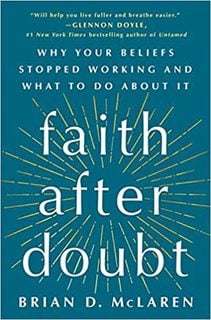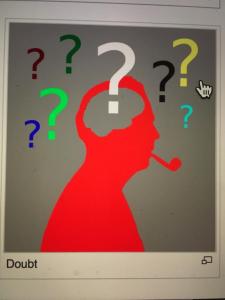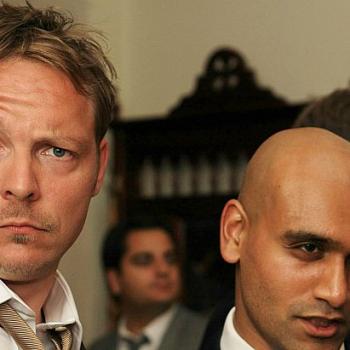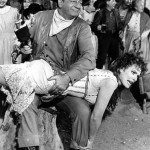Editor’s Note: In a book store for the first time in over a year, I came upon a book about getting your religion back and thought it would be perfect for Alexis Record to review for the blog. I was right; except it turns out she prefers a conversation to a book review. /Linda LaScola, Editor
==============================
By Alexis Record
Forget my usual book review format; let’s have a whole conversation about Faith After Doubt: Why Your Beliefs Stopped Working and What to Do About It by Brian D. McLaren.
Of all the people who retain the label I have rejected, it’s the progressive, non-fundamentalist Christians who are the most rewarding to work alongside in my role as a community organizer. The Venn diagram of overlapping values between McLaren and myself may only deviate on the fringes by a bit of a worldview difference and a small number of buzzwords. As a result, it was easy to appreciate and even love many parts of his book.
Faith After Doubt gave me insight into the thought process of Christians who have broken free of fundamentalist beliefs. I am impressed by the amount of toil it takes these folks to revolutionize their faith. It is backbreaking, brow drenching, often lonely, exhausting, yet rewarding work. I wonder what Christianity’s landscape will look like in fifty years as this next generation digs up entrenched evangelical doctrines. I’m honestly excited for them.
I did, however, have several quibbles with this book such as how it begins with a quote from a transphobic author, considers C. S. Lewis a great thinker, calls Tolkien a Protestant writer, includes lots of Bible quoting, and holds up faith as the best option. Admittedly, some of these are somewhat picky and the Tolkien thing may have been an editing error. (He was Catholic, but Protestants love him.) Overall, I thought McLaren’s theory of faith was pretty sound as far as theories go and I could see the appeal of going through the faith stages he outlines.
The brightest parts of his book were when Rachel Held Evans was quoted. Reading her private notes and re-reading her blog snippets made me downright weepy. Including her voice was a gift. I miss her. We all miss her.
This book is clearly about faith, so being the faith-emancipated person that I am I realize I am not the intended audience. And that’s okay. I appreciate anyone who describes faith as something they want to pursue without simultaneously disparaging non-faith. I acknowledge that that is difficult to do, and even though Faith After Doubt does fail to reach this standard at times, it seems to do so unconsciously or unintentionally, like an implicit bias rather than any sort of animosity. In honor of that, I wanted this to become more of a conversation than a critique. I may not have a legitimate seat at the table here, but I do want to point out any time the subject matter runs over the toes of people like me. For starters, let’s talk about the implied premise that faith should be the ultimate goal for everyone.
When Faith is the End Goal
A friend who is currently deconstructing her faith got a presumptuous social media comment from a loved one saying,
“I can’t wait to see how much closer your relationship is with God after you deconstruct!”
My friend is coming down on the side of agnosticism and got the message quite clearly that she will not have a safe place to land.
I’ve seen a lot of blog posts and Tik Toks from pastors desperately trying to subvert their congregations’ view of deconstruction by framing it as overcoming doubt by any means or achieving better faith.
Thankfully, Faith After Doubt, written by a retired pastor, didn’t give me a similar sketch vibe. It did, nevertheless, paint the best outcome of struggling with doubt as keeping one’s faith, which can introduce a pass/fail aspect to this process.
My strongly held assertion is that anywhere a person ends up after deconstruction is valid. The outcome for some may be a more authentic faith, yet that is not the ultimate state of being and therefore not the ultimate outcome. For many others, faith simply does not work, either because of how they are wired or due to what they value.
Can we really be truly open-minded when there is an established mental destination in mind?
The point of deconstruction is taking the worldview you inherited, deciding piece by piece what is salvageable or what needs to be knocked down, and rebuilding something healthier, truer, and better for yourself. There are those who accept their ideological house exactly as is, but if their lead paint or faulty wiring hurts anyone, we would blame the homeowner, not solely the original homebuilder.
Similarly, ideas need to be updated, more so as they age. Whatever updates or demolition done to the home benefits not only the person living there, but also the entire neighborhood. Of course, plenty of homes need to be completely leveled and walked away from, no matter how much we wish to live in them.
You Can Win the Game By Not Playing
Maintaining faith after doubt isn’t limited to McLaren’s understanding of Christian faith. Often he notes that his reader could be Catholic or Muslim or something else. I love the inclusivity and the acknowledgment that this kind of deconstruction of any faith system has a Universalist aspect to it. However, it does bring me back to my discomfort with faith being the goal.
What is so great about faith? Is it a virtue? Is it parallel with truth or does it somehow exist outside of it? Does the object of faith need to be real for the faith to be valid? Faith is a desire of many people who would reach for this book, but is it necessary?
If faith is important for us to have, there better be some darn good arguments presented to back that up. We’re sold on the idea that it’s important to YOU. That’s great for you; go pursue your passions. We’ll be over here.
I once became addicted to a free game app on my phone. I discovered that for only $0.99 I could buy my way into lots of items and rewards, bypassing days of gameplay. Unfortunately, I didn’t keep great track of how often I was making that one-click purchase until I got the total in my credit card statement. This led to a conversation with my spouse. I responded by creating a strict budget for future purchases and outlining the steps I would be taking to prevent this from happening again. I shared this using a PowerPoint presentation as all normal people do. There were graphs.
His response was simply,
“Or you could delete the app.”
Not play the game? Had this man never heard of the sunk cost fallacy? Did he not realize how happy this game made me? Suffice to say, it was the most ridiculous suggestion I’d ever heard.
I went on to spend over 50 more dollars on this app before I finally deleted it. The level I reached as well as all of the special items I had collected disappeared like the meaningless zeros and ones that they were. I grieved its loss at first, but found I had hours of my life back. The importance of the app disappeared over time and now I don’t miss it at all. I think there’s a metaphor here.
Best Possible Life
McLaren says that many people “get off the religious bus” in their quest for success, fulfillment, and personal development. The very next sentence is:
“But others aren’t so easily satisfied.” (p. 63)
This is several steps above calling us “lazy learners,” but not much better. It implies that people who leave religion are not striving for what is best; they’re fine with giving up and settling. That doesn’t make us sound very good. In fact, these parts were difficult to read as this sentiment gets doubles down on later in the book:
“In the absence of that aliveness, in the absence of that faith after doubt that expresses itself in love, people settle for less.” (p. 191)
I wouldn’t describe my life as less. I sometimes wonder if Christians assume atheists never have transcendent experiences? As if our brains don’t light up at stimulus just because it’s not religious stimulus and experience awe?
If there were only one negative reference to those who don’t embrace faith, I would try to mentally skip over it like I did with the line about Tolkien being a Protestant writer. Unfortunately, this idea is woven through the book’s examples. For instance, on page 75 we find the term “spiritually bankrupt”–something Stage Two Complexity people fear becoming as they move onto Stage Three Perplexity in McLaren’s theory. This is a term I heard a lot in my fundie years. While it can be the legitimate fear of a believer who feels a real sense of loss at the idea of deleting it all, it does communicate something negative about people like me: We are missing something, in a state of loss, poor, the poorest.
If a book is not for us, it should be careful how it speaks about us.
On page 38, we learn Sam’s story. He had reached an impasse between two paths: Staying in his faith or experiencing utter meaninglessness. Seriously, utter meaninglessness. What must my life look like to someone like that? I’m not saying he wasn’t being honest about how he felt, but I wish the author had done more to correct Sam’s misconception. Unfortunately, I suspect he feels the same way.
Again, there’s so much I appreciate about Faith After Doubt that it almost feels overly picky to harp on how my particular identity is portrayed. To be clear, never once did the author say something outright derogatory about atheists or secular people. I only hold this book up to a higher standard because I respect the higher standard it reaches for.
On that note, it’s not appropriate to apply a Christian worldview, no matter how enlightened or progressive, to those who do not share it. To do so could be construed as having a colonialism mindset. (Stay with me.)
In the book, Hannah is the closest example of an agnostic atheist we get with her statement that she didn’t feel like she had faith in God, whatever she meant by that. She continues to fight for what is right despite these feelings. Our author tells her that this strikes him as the greatest kind of faith. She corrects him that instead maybe it’s love.
McLaren again oversteps when he says the spirit of God informs and guides non-religious humanist communities doing good in the world. (p. 144) The humanist motto is literally “Good without God,” making his assertion particularly abrasive.
A better way is to avoid applying your terms to those who do not claim them, but especially to those who have rejected them. There is a way to appreciate one another without projecting and applying our own ideas onto them. Those with Christian privilege must take extra care when talking about, and on behalf of, the rest of us.
Because the Alternative is Unthinkable
The reason McLaren gives for not embracing secularism is based on his experience as a counter-protestor at the 2017 Unite the Right rally that resulted in the death of Heather Heyer. After reading private conversations from the rally’s organizers, McLaren concluded that these folks had traded Christianity for white supremacy and fascism.
I waited for him to bring this back to secularism and then it hit me; the white supremacists were his example of secularists.
“[When] people leave traditional religious identity behind, or subordinate it to a political or racial ideology, they don’t advance to a blissful secular harmony. No: we humans just as easily shift the sense of identity we once found in a passionate Stage One or State Two religious faith into what we might call quasi-secular religions like racism, nationalism, fascism, classism, and other -isms.” (p. 110)
Many in my community, myself included, left traditional religious identity behind. I would hold any one of my friends up as a counterexample to this idea. My Sunday Assembly is the epitome of blissful secular harmony, sir. These statements need some serious qualifiers such as “some” and “the bad ones” or he needs to provide some data showing secular people are more at risk of radicalization and violence than the faithful.
He goes on:
“If we humans don’t find meaning, belonging, and purpose in healthy forms of spirituality, we’ll seek them in unhealthy forms of ideology… That’s one reason I can’t give up on faith.” (p. 111-112)
You can see how this statement is an erasure to so many good people. It also puts me in the defensive position; I absolutely have meaning, belonging, and purpose in my life outside of spirituality, thank you very much. Yet he believes those things are:
“Exactly what religious faith is supposed to provide.” (p. 111)
Now I don’t know the things the author read in those awful private conversations of the rally organizers; I can only speak to my experience as someone who is related to the head organizer of that hateful rally. I watched this family member grow up and become radicalized. If anyone thinks Christianity had nothing to do with that process, I would strongly disagree. Christian faith is not in any way an inoculation against white supremacy. What is? To echo Hannah, maybe it’s love.
I understand that for those who see faith as a good thing, it follows easily to demonize–consciously or unconsciously–those living without it. There’s good news to rejecting McLaren’s conclusion here: Those who are in long stretches of doubt do not need to fear losing meaning and purpose and, you know, morph into neo-Nazis. That’s not how any of this works.
“Love your neighbor should be done in a way that your atheist neighbor would also call it love.” Pastor Megan Rohrer
I would encourage anyone practicing a faith after doubt that expresses itself in love to remember the Venn diagram that is practically a circle with many of those outside the faith. Then speak to them, but especially about them, in ways they would find accurate and loving.
**Editor’s Question** Whether or not you’ve read the book, what do you have to add to Alexis’s conversation about it?
======================
 Bio: Alexis Record is a feminist, humanist, ex-Christian atheist, and mother to children with disabilities. She devoted the first 30 years of her life to Christian study and service due to indoctrination, and is working to repair the years the locusts have eaten.
Bio: Alexis Record is a feminist, humanist, ex-Christian atheist, and mother to children with disabilities. She devoted the first 30 years of her life to Christian study and service due to indoctrination, and is working to repair the years the locusts have eaten.
>>>>Photo Credits: https://www.amazon.com/Faith-After-Doubt-Beliefs-Stopped/dp/1250262771?asin=1250262771&revisionId=&format=4&depth=1 ; By © Nevit Dilmen, CC BY-SA 3.0, https://commons.wikimedia.org/w/index.php?curid=12214419















